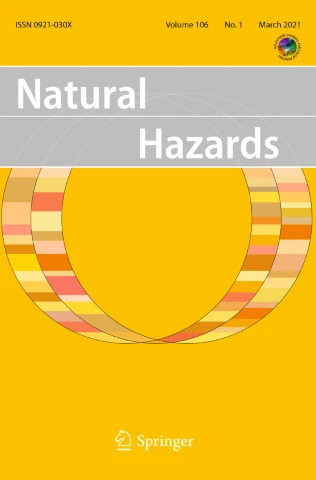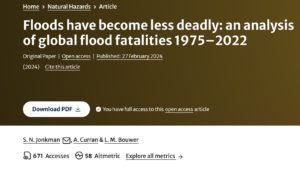https://link.springer.com/article/10.1007/s11069-024-06444-0
Floods have become less deadly: an analysis of global flood fatalities 1975–2022
Abstract
Floods are amongst the most frequent disasters in terms of human and economic impacts. This study provides new insights into the frequency of loss of life at the global scale, mortality fractions of the population exposed to floods, and underlying trends. A dataset is compiled based on the EM-DAT disaster database covering the period 1975 until 2022, extending previous studies on this topic. Flood impact data are analysed over spatial, temporal and economic scales, decomposed in various flood types and compared with other natural disasters. Floods are the most frequent natural disasters up to 1000 fatalities, and flash floods lead to the highest mortality fractions per event, i.e. the number of deaths in an event relative to the exposed population. Despite population growth and increasing flood hazards, the average number of fatalities per event has declined over time. Mortality fractions per event have decreased over time for middle- and high-middle-income countries, but increased for low-income countries. This highlights the importance of continuing and expanding risk reduction and adaptation efforts.
…
4 Discussion and conclusions
In our study, we find that the number of flood events has increased over time with a slower overall increase since 2000 and a decrease of the annual number of large events (≥ 100 fatalities) since that year. The average number of people killed and affected per event has decreased over time. Since 1975, year-on-year declines of roughly 6 fatalities and over 30,000 persons affected per event are observed.
A key question is which drivers have caused these trends. Increased reporting and effects of climate change would lead to increasing numbers of flood events. Climate change would lead to more frequent flood events and higher intensities (IPCC 2023). Population and exposure growth would mainly result in increasing event impacts. Measures to reduce vulnerability, e.g. better warning and shelters, will lead to a reduction in the mortality fraction. Protective measures, such as flood defences, will prevent flood events or lower exposure by protecting parts of the population. Since all these factors change over time, mortality fractions and average impacts per event are considered key indicators for tracking relative impact of flood events. These indicators can be used to compare trends in different countries, regions and income groups and are more time-consistent and robust metrics than total annual fatalities.
Note that the above effects are not fully independent: climate change could lead to stronger floods and higher impacts at the event level, but local adaptation through increased dike height and strength could prevent disasters in those locations.
It is striking that the total number of annual flood fatalities is rather constant over time, as there have been large changes in exposure in the past decades. Over the considered period, the global population has grown substantially from 4 to almost 8 billion people (source: https://data.worldbank.org/indicator/SP.POP.TOTL, accessed October 312023). Substantial part of this growth has taken place in flood prone areas along coasts and in river basins, leading to increases in the exposed population (Tellman et al. 2021; Rentschler et al. 2023).
A key cause for the resulting downward temporal trend in the average number of people killed per event concerns improved flood risk management practices over the last decades. This includes increased protection, better warning, forecasting and early warning communication and other forms of risk reduction. These are general trends; reports from recent individual events clearly point out failures in risk management. For example, for the deadly summer 2021 floods that affected multiple countries in Northwestern Europe most fatalities (more than 180) occurred in Germany, but flood warnings failed to reach most of the affected residents, and many were not prepared to act on the warning information (Thieken et al. 2023). At the same time, there are successful examples: in Bangladesh, improved forecasting, early warning and cyclone shelters, as well as improved coastal protection has led to progressively decreasing fatalities in similar cyclone-related coastal flooding (Paul 2009; Bouwer and Jonkman 2018). Also in the western world, improved flood protection, for instance, in the city of Hamburg after the 1962 flood disaster has avoided loss of life in more severe storm surge events in the years since (Kron and Müller 2019). Also, the New Orleans hurricane protection system that was built after the catastrophic flooding due to hurricane Katrina in the year 2005 has prevented flooding and loss of life during subsequent hurricanes, such as Isaac in 2012.
Our results confirm the finding that mortality from flood events has declined over time (Jongman et al. 2015; Tanoue et al. 2016; Formetta and Feyen 2019) and also show that average fatalities per event have declined for all flood types, and not just for large-scale coastal flood events (Bouwer and Jonkman 2018). However, we did not find statistically significant declining trends in the total annual number of people killed or affected per year on a global scale. The reduction of average impacts per event seems to be “compensated” by an increase over time of the number of reported events (Fig. 1) and the increased exposure due to population growth (see above). The trends in flood fatalities (a stabilization of the annual total and a decline in average fatalities per event) are opposed to trends in damages from weather-related extreme events (including floods) which have increased (Coronese et al. 2019). However, this damage increase is largely caused by increasing exposure of capital in urban areas (Bouwer 2019; Geiger and Stomper 2020).
Floods have become less lethal over time in many regions. Especially middle-income countries have succeeded in reducing mortality from flooding, while low-income countries have witnessed an increase after the year 2000 (Fig. 5). For high-income groups, we find no trend. In both cases, potential explanations may be the increased exposure in the floodplains. In low-income countries, people are increasingly moving into floodplains due to lack of available options without the implementation of substantial risk reduction. In middle-income countries, increasing financial and other resources to protect and warn populations would lead to reduced vulnerabilities. This is different from the inverted U-shape in vulnerability, found in other studies for total mortality (Tanoue et al. 2016; Kellenberg and Mobarak 2008). Here we demonstrate the relationship between income level and mortality for average mortality fractions per event, which is a more robust indicator. The difference with other studies could be due to the fact that here we have recorded the mortality for the income group at the time of the event, so countries move from one income group to another over time. This accurately reflects the risk of the income level group at that time.
This study complements an earlier study (Jonkman 2005) on global patterns in loss of life, which considered the period 1975–2002. It extends the dataset beyond 2002 with 20 years of data and adds information on coastal floods for all years. While the 2005 study suggested a slight increase in the number of killed and affected per event, the present study shows a declining trend when the longer period 1975–2022 is considered. The 2005 study also highlighted a growth in the number of reported events up until 2002. The analyses in the present article show that an increase in reporting through wider availability of media and internet resources has played a role in the initial increase in reported events.
Our analysis is based the publicly available global disaster database EM-DAT. A number of main issues included the consistency in reporting, the classification of combined coastal windstorm and flood events and the effects of data collection and reporting efforts on observed upward global temporal trends. Tracking global trends in vulnerability and disaster mortality—particularly in line with the goals of the Sendai Framework—requires a consistent data basis over time. It is thus important to minimize and correct for temporal trends in the analysis of disaster mortality statistics. Also, the use of the time-consistent indicators from this study (event mortality and average number of fatalities) can be utilized to monitor progress towards reducing risk and impacts from flooding and other disasters.







